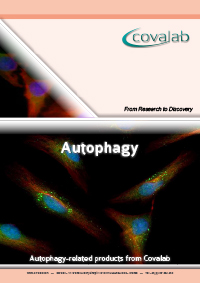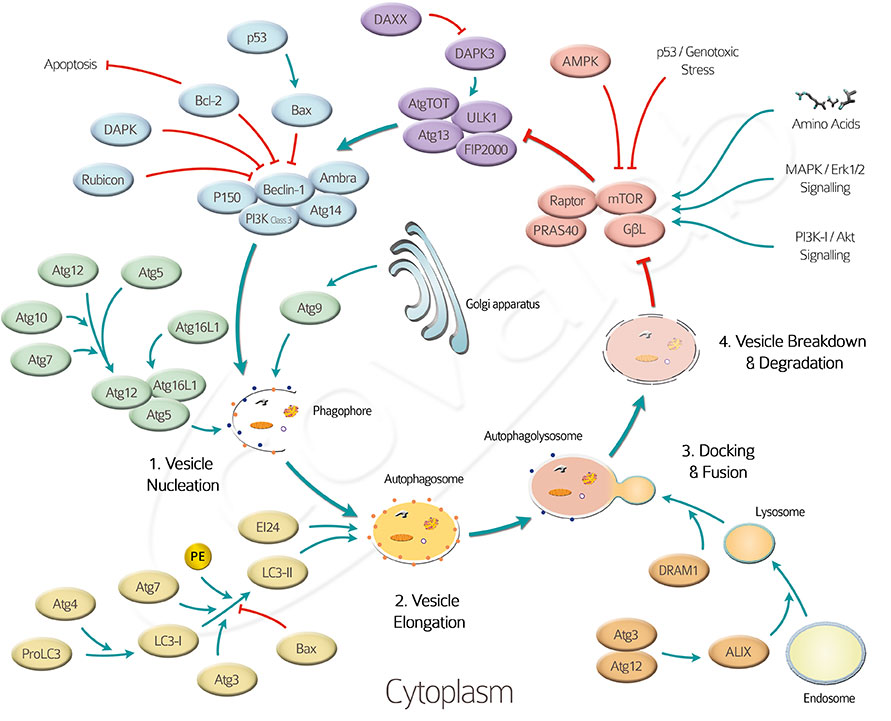We use cookies to make your experience better. To comply with the new e-Privacy directive, we need to ask for your consent to set the cookies. Learn more.
Autophagy
Autophagy-related products from Covalab
Autophagy is a way that cells use for organelles recycling 1. The main process involves the segregation and delivery of cytoplasmic cargo, including proteins and organelles, for degradation by hydrolytic enzymes in lytic vacuoles (lysosomes) also called “autophagolysosomes” or “ autolysosomes”. Three types of autophagy have been described in the litterature so far 2:
Macroautophagy, which sequestrates damaged organelles and unused proteins.
Microautophagy, in which lysosomes directly engulf cytoplasm by invagination.
Chaperone-mediated autophagy, which selectively sequester proteins containing a consensus sequence recognised by the hsc70-containing chaperone/co-chaperone complex.
Although described in the early 60’s, it is only recently that autophagy gained interest for its implication as a basal mechanism in cell homeostasis and development but also to determine the role of induced Autophagy in host-pathogen interaction 3, cell survival under stress conditions and diseases (neurodegenerative and cancer).
Covalab provides antibodies targeting key components of the autophagic pathway like Beclin 1 and ATG proteins implicated in autophagososmes formation, Caspases involved in autophagic programmed cell death and lytic enzymes and membrane proteins for vacuole function. Discover these antibodies and more in the following list.
Browse our complete Autophagy-related products range or click the image above to display our interactive pathway!
Download Files

Download our dedicated brochure and find what you need among our autophagy-related products!
References:
- 1 - Autophagic recycling: lessons from yeast help define the process in plants: Thomson AR. & Vierstra RD.; Cur. Opin. Plant Biol. 2005 Apr;8(2):165-73.
- 2 - Autophagy: process and function; Mizushima N.; Genes & Dev. 2007 Nov 15;21:2861-73.
- 3 - Autophagy and bacterial infectious diseases: Yuk JM., Yoshimori T. and Jo EK.; Exp. Mol. Med. 2012 Feb 29;44(2):99-108.
- 4 - Guidelines for the use and interpretation of assays for monitoring autophagy: Klionsky DJ. et al.; Autophagy 2012 Apr;8(4):445-544.
- 5 - Autophagy in the pathogenesis of disease: Levine B. & Kroemer G.; Cell 2008 Jan 11;132(1):27-42.
- 6 - Activation of the MAPK11/12/13/14 (p38 MAPK) pathway regulates the transcription of autophagy genes in response to oxidative stress induced by a novel copper complex in HeLa cells: Zhong W. et al.; Autophagy 2014 Jul;10(7):1285-300.
- 7 - Regulation of PIK3C3/VPS34 complexes by MTOR in nutrient stress-induced autophagy: Yuan HX., Russell RC. & Guan KL.; Autophagy 2013 Dec;9(12):1983-95.
- 8 - The p53-induced gene Ei24 is an essential component of the basal autophagy pathway: Zhao YG. et al.; J. Biol. Chem. 2012 Dec 7;287(50):42053-63.
- 9 - DRAM1 regulates autophagy flux through lysosomes: Zhang XD. et al.; PLoS One 2013 May 17;8(5):e63245.
- 10 - DAP-kinase and autophagy: Levin-Salomon V. et al.; Apoptosis 2014 Feb;19(2):346-56.
- 11 - ATG12-ATG3 interacts with Alix to promote basal autophagic flux and late endosome function: Murrow L. et al.; Nat. Cell. Biol. 2015 Mar;17(3):300-10.

